If you’re as bullish on oil as I am, let’s look past vanilla bean favorites like Exxon Mobil (XOM) and Chevron (CVX). Great companies but a bit pricey, as they only yield 3% to 4%.
We’re better off with diversified energy funds that dish dividends up to 9%. Now we’re talking!
The conditions are right for another push ahead in energy’s crash-‘n’-rally cycle. The Middle East (‘nuff said). The Federal Reserve careening towards a “no landing” scenario. And the People’s Bank of China (PBoC) joining the global money printing party.
It could be high time for Texas tea’s next leg higher. To celebrate, let’s review three closed-end funds (CEFs) that yield 7% to 9% and trade at discounts up to 11%.
BlackRock Energy & Resources Trust (BGR)
Distribution Rate: 7.0%
The BlackRock Energy & Resources Trust (BGR) owns energy equities—integrated energy majors, exploration and production (E&P) firms, distribution companies and more. It’s diversified from a geographic standpoint; 70% of the fund is invested in American firms such as Exxon Mobil (XOM) and ConocoPhillips (COP), while the remaining 30% is dedicated to international energy stocks including the U.K.’s Shell (SHEL) and France’s TotalEnergies (TTE). The tight portfolio of fewer than 30 holdings isn’t surprising for an actively managed fund, but BGR is really top-heavy, with Exxon accounting for more than 20% of assets (yikes!) and Shell another 10% or so.
Also, while many CEFs are happy to use debt to crank up their exposure, BGR doesn’t use a cent of leverage.
But this BlackRock fund does have a few familiar CEF traits. It pays monthly distributions, which we won’t find in basic sector ETFs. It also trades at a nice 11% discount to its net asset value (NAV), which is a slightly deeper bargain than its ~10% five-year average discount.
Most importantly, BGR trades options. Specifically, management uses a covered call strategy, which is how it manages to squeeze a 7% yield out of the same companies that fund the Energy Select Sector SPDR ETF’s (XLE) 3%-plus yield without debt leverage.
Is it a better way to invest in energy? Well, two charts tell the tale.
Distributions? They’ve Actually Shrunk Over Time
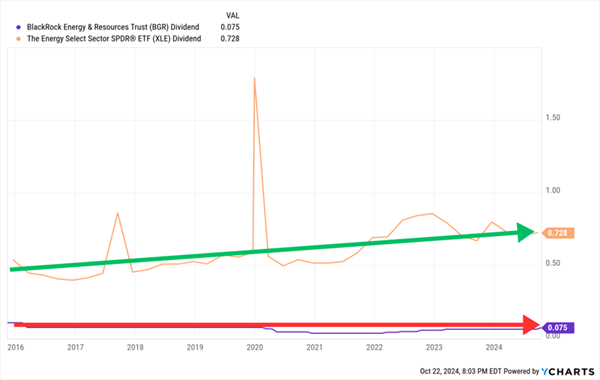
After Years of Keeping It Close, BGR Really Starts to Lag
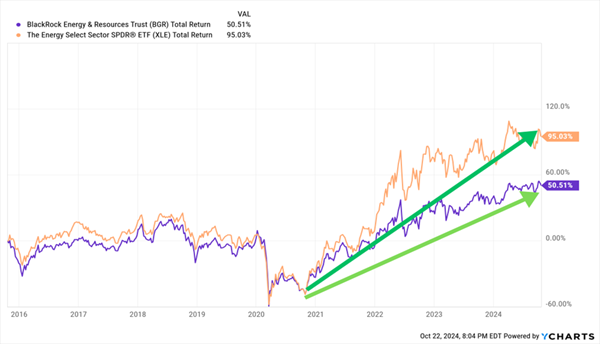
BGR’s primary quality is guarding against downside (thanks to the covered calls), but even then, it hasn’t delivered much protection during really precipitous drops. In the meantime, we enjoy oh so much less of the upside.
Adams Natural Resources Fund (PEO)
Distribution Rate: 9.1%
Adams Natural Resources Fund (PEO) is another largely straightforward energy-sector CEF, though it’s far more established. This fund came to life in 1929, meaning it’s all of about five years away from celebrating its centennial. It also has a storied distribution history, paying its shareholders for more than 80 years.
PEO has a wider portfolio than BGR, at just less than 60 holdings, and it’s chock full of energy blue chips such as Exxon, Chevron, Schlumberger (SLB) and Marathon Petroleum (MPC). Oddly, though, it also has substantial (14%) exposure to chemicals firms like Linde (LIN), and a peppering of other industries, such as metals, mining, containers/packaging and construction materials.
But it’s arguably more buttoned up than the BlackRock fund. It does utilize leverage, but a trace amount of it (sub-1%). Nor does it trade options.
The result is nothing to scream about, but PEO does offer occasional bursts of outperformance.
Once in a While, PEO Gives Us an Edge
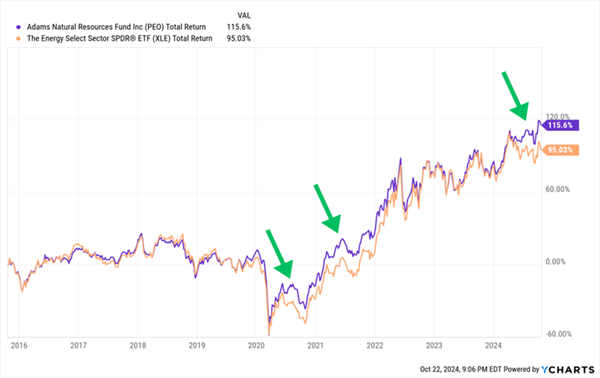
The 11% discount to NAV is a little misleading, too. We’re buying its assets on sale, sure, but we can do better—PEO’s average discount over the past five years is above 14%.
ClearBridge Energy Midstream Opportunity Fund (EMO)
Distribution Rate: 8.9%
Of course, most of us know if we really want income out of the energy space, we need to forget plain-Jane integrated majors and E&P firms, and instead look toward the infrastructure providers. Specifically, master limited partnerships (MLPs).
The bulk of CEFs investing in the energy space are concentrated in MLPs.
Among the most interesting is ClearBridge Energy Midstream Opportunity Fund (EMO), which is happy to own midstream firms (read: pipelines, storage, terminals, etc.) in partnership and corporation form. But its portfolio is thick in MLPs, including top 10 holdings such as Energy Transfer LP (ET), MPLX LP (MPLX) and Enterprise Products Partners LP (EPD).
EMO gives us plenty to digest here.
The fund does what CEFs tend to do—despite a modest 6% in leverage, EMO acts like a more exaggerated version of an index fund, booming when basic MLP ETFs are up, and languishing when they’re down.
EMO Has Underperformed Over Time, But It Has Handily Doubled AMZA Off the 2020 Lows
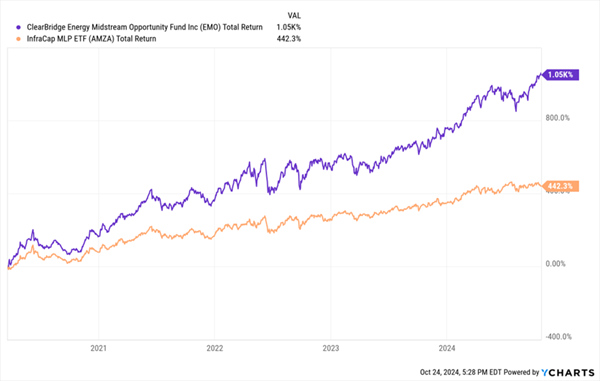
As a result of its run since 2020, EMO isn’t all that cheap. Yes, its assets are trading at 90 cents on the dollar. But we can do better—it has traded at an average discount of 16% over the past five years, including a stint near that average earlier in 2024.
It’s also more than meets the eye. EMO actually merged with two funds—ClearBridge MLP and Midstream Fund, and ClearBridge MLP and Midstream Total Return Fund—in early September, and a couple weeks later, the company announced that Chris Eades would step down from the portfolio management team effective as of the end of 2024.
And snuck into the middle of all that? An upgrade to monthly dividends.
Want an example of just how disrespected CEFs are? If we go to just about any data provider, they’ll tell us that EMO yields around 3% right now. But it doesn’t! More than a month removed from a change to the fund’s dividend policy, and they’re still calculating the new 33-cent payout on a quarterly basis (3%) rather than monthly (9%).
A Change in Policy Also Messes With the Dividend Chart
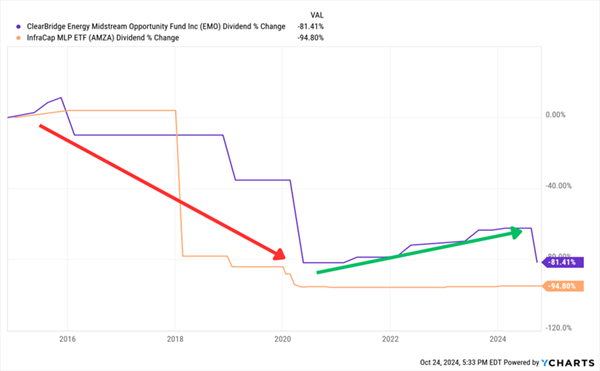
The monthly dividend is certainly more aligned with investors’ interest, but we have to be careful here. Even plain-vanilla index funds like the InfraCap MLP ETF (AMZA) deal with dividend declines; unlike traditional companies that will maintain a specific dividend level, MLPs’ distributions tend to shift with their profits. With EMO, that dynamic is exaggerated, leaving us with larger fluctuations in payouts over time.
This Monthly Dividend Portfolio Pays Us 8% (Without the Drama!)
The reason why funds like EMO and PEO remain with the “B squad” isn’t because they’re chintzy—they’re not!
It’s because they’re inconsistent.
Fortunately, there are plenty more CEFs out there (500 in all), and many of them are able to give us dividends that are both juicy and reliable.
I’ve gone through all of them and filtered out the very best ones—at the best values—for my “8%+ Monthly Payer Portfolio.”
As the name says, this unique portfolio kicks out an 8% dividend, and those payouts roll our way every single month. They’re timely buys now, especially as rates fall, making high-income opportunities like this one harder and harder to find.
Don’t miss out on these terrific income plays while you can still get in at a bargain. Click here for all the details and to download a FREE Special Report revealing the names and tickers of all the stocks and funds in my 8%+ Monthly Payer Portfolio.
